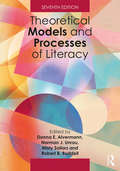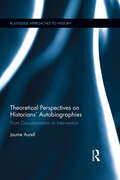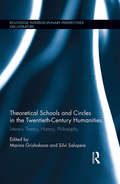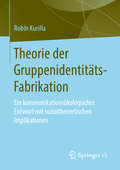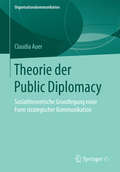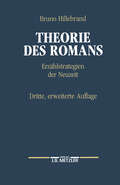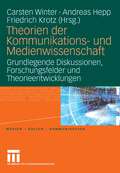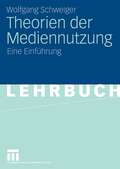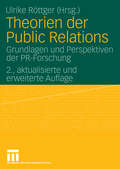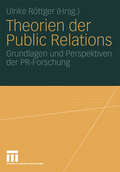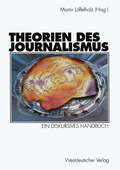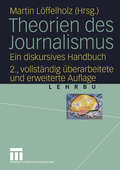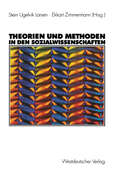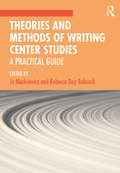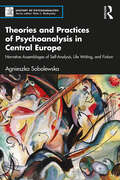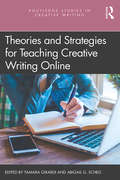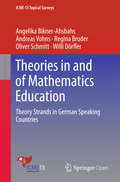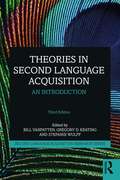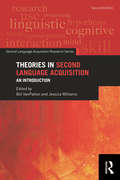- Table View
- List View
Theoretical Models and Processes of Literacy
by Donna E. Alvermann Norman J. Unrau Misty Sailors Robert B. RuddellThe Seventh Edition of this foundational text represents the most comprehensive source available for connecting multiple and diverse theories to literacy research, broadly defined, and features both cutting-edge and classic contributions from top scholars. Two decades into the 21st century, the Seventh Edition finds itself at a crossroads and differs from its predecessors in three major ways: the more encompassing term literacy replaces reading in the title to reflect sweeping changes in how readers and writers communicate in a digital era; the focus is on conceptual essays rather than a mix of essays and research reports in earlier volumes; and most notably, contemporary literacy models and processes enhance and extend earlier theories of reading and writing. Providing a tapestry of models and theories that have informed literacy research and instruction over the years, this volume’s strong historical grounding serves as a springboard from which new perspectives are presented. The chapters in this volume have been selected to inspire the interrogation of literacy theory and to foster its further evolution. This edition is a landmark volume in which dynamic, dialogic, and generative relations of power speak directly to the present generation of literacy theorists and researchers without losing the historical contexts that preceded them. Some additional archival essays from previous editions are available on the book’s eResource. New to the Seventh Edition: Features chapters on emerging and contemporary theories that connect directly to issues of power and contrasts new models against more established counterparts. New chapters reflect sweeping changes in how readers and writers communicate in a digital era. Slimmer volume is complemented by some chapters from previous editions available online.
Theoretical Perspectives on Historians' Autobiographies: From Documentation to Intervention (Routledge Approaches to History)
by Jaume AurellE. H. Carr wrote, "study the historian before you begin to study the facts." This book approaches the life, work, ideas, debates, and the context of key 20th- and 21st-century historians through an analysis of their life writing projects viewed as historiographical sources. Merging literary studies on autobiography with theories of history, it provides a systematic and detailed analysis of the autobiographies of the most outstanding historians, from the classic texts by Giambattista Vico, Edward Gibbon and Henry Adams, to the Annales historians such as Fernand Braudel, Philippe Ariès and Georges Duby, to Marxist historians such as Eric Hobsbawm and Annie Kriegel, to postmodern historians such as Carolyn Steedman, Robert A. Rosenstone, Carlos Eire, Luisa Passerini, Elisabeth Roudinesco, Gerda Lerner and Sheila Fitzpatrick, and to "interventional" historians such as Geoff Eley, Jill Ker Conway, Natalie Davis and Gabrielle Spiegel. Using a comparative approach to these texts, this book identifies six historical-autobiographical styles: humanistic, biographic, ego-historical, monographic, postmodern, and interventional. By privileging historians' autobiographies, this book proposes a renewed history of historiography, one that engages the theoretical evolution of the discipline, the way history has been interpreted by historians, and the currents of thought and ideologies that have dominated and influenced its writing in the 20th and 21st centuries.
Theoretical Perspectives on Historians' Autobiographies: From Documentation to Intervention (Routledge Approaches to History #15)
by Jaume AurellE. H. Carr wrote, "study the historian before you begin to study the facts." This book approaches the life, work, ideas, debates, and the context of key 20th- and 21st-century historians through an analysis of their life writing projects viewed as historiographical sources. Merging literary studies on autobiography with theories of history, it provides a systematic and detailed analysis of the autobiographies of the most outstanding historians, from the classic texts by Giambattista Vico, Edward Gibbon and Henry Adams, to the Annales historians such as Fernand Braudel, Philippe Ariès and Georges Duby, to Marxist historians such as Eric Hobsbawm and Annie Kriegel, to postmodern historians such as Carolyn Steedman, Robert A. Rosenstone, Carlos Eire, Luisa Passerini, Elisabeth Roudinesco, Gerda Lerner and Sheila Fitzpatrick, and to "interventional" historians such as Geoff Eley, Jill Ker Conway, Natalie Davis and Gabrielle Spiegel. Using a comparative approach to these texts, this book identifies six historical-autobiographical styles: humanistic, biographic, ego-historical, monographic, postmodern, and interventional. By privileging historians' autobiographies, this book proposes a renewed history of historiography, one that engages the theoretical evolution of the discipline, the way history has been interpreted by historians, and the currents of thought and ideologies that have dominated and influenced its writing in the 20th and 21st centuries.
Theoretical Schools and Circles in the Twentieth-Century Humanities: Literary Theory, History, Philosophy (Routledge Interdisciplinary Perspectives on Literature)
by Marina Grishakova Silvi SalupereSchools and circles have been a major force in twentieth-century intellectual movements. They fostered circulation of ideas within and between disciplines, thus altering the shape of intellectual inquiry. This volume offers a new perspective on theoretical schools in the humanities, both as generators of conceptual knowledge and as cultural phenomena. The structuralist, semiotic, phenomenological, and hermeneutical schools and circles have had a deep impact on various disciplines ranging from literary studies to philosophy, historiography, and sociology. The volume focuses on a set of loosely interrelated groups, with a strong literary, linguistic, and semiotic component, but extends to the fields of philosophy and history—the interdisciplinary conjunctions arising from a sense of conceptual kinship. It includes chapters on unstudied or less studied groups, such as Tel Aviv School of poetics and semiotics or the research group Poetics and Hermeneutics. The volume presents a significant supplement to the standard historical accounts of literary, critical, and related theory in the twentieth century. It enhances and complicates our understanding of the twentieth-century intellectual and academic history by showing schools and circles in the state of germination, dialogue, controversy, or decline, in their respective historical and institutional settings, while reaching simultaneously beyond those dense settings to the new cultural and ideological situations of the twenty-first century.
Theoretical Schools and Circles in the Twentieth-Century Humanities: Literary Theory, History, Philosophy (Routledge Interdisciplinary Perspectives on Literature #42)
by Marina Grishakova and Silvi SalupereSchools and circles have been a major force in twentieth-century intellectual movements. They fostered circulation of ideas within and between disciplines, thus altering the shape of intellectual inquiry. This volume offers a new perspective on theoretical schools in the humanities, both as generators of conceptual knowledge and as cultural phenomena. The structuralist, semiotic, phenomenological, and hermeneutical schools and circles have had a deep impact on various disciplines ranging from literary studies to philosophy, historiography, and sociology. The volume focuses on a set of loosely interrelated groups, with a strong literary, linguistic, and semiotic component, but extends to the fields of philosophy and history—the interdisciplinary conjunctions arising from a sense of conceptual kinship. It includes chapters on unstudied or less studied groups, such as Tel Aviv School of poetics and semiotics or the research group Poetics and Hermeneutics. The volume presents a significant supplement to the standard historical accounts of literary, critical, and related theory in the twentieth century. It enhances and complicates our understanding of the twentieth-century intellectual and academic history by showing schools and circles in the state of germination, dialogue, controversy, or decline, in their respective historical and institutional settings, while reaching simultaneously beyond those dense settings to the new cultural and ideological situations of the twenty-first century.
Theorie der Gruppenidentitäts-Fabrikation: Ein kommunikationsökologischer Entwurf mit sozialtheoretischen Implikationen
by Robin KurillaBisher gibt es keine umfassende und kohärente Annäherung an die Bestimmung der an der Konstruktion von Gruppenidentitäten beteiligten kommunikativen und präkommunikativen Prozesse. Die vorliegende Untersuchung schließt diese Lücke durch die Entwicklung einer einheitlichen theoretischen Grundlage, mit der sich empirische Konstruktionsprozesse erfassen lassen. Überdies leistet sie einen Beitrag zur Domäne der Gruppenkommunikationsforschung. Es wird ein grundlagentheoretisches Flussbett geschaffen, das eine begriffliche Fundierung der Konzeption von Inter- und Intragruppenkommunikation liefert, die nicht von ‚objektiven’ Kategorien ihren Ausgang nimmt, sondern von de facto stattfindenden Vergesellschaftungsprozessen. Zudem wird am Beispiel der Gruppenidentitätskonstruktion die Architektur einer innovativen Sozialtheorie vorgestellt, die den Ansprüchen kommunikationswissenschaftlicher und womöglich auch in anderen Disziplinen zu verortender Erkenntnisinteressen genügt.
Theorie der Public Diplomacy: Sozialtheoretische Grundlegung einer Form strategischer Kommunikation (Organisationskommunikation)
by Claudia AuerClaudia Auer entwickelt eine Theorie der Public Diplomacy, die handlungstheoretische Ansätze mit makrosoziologischen Perspektiven zusammenführt. Detailliert analysiert sie einen bislang kaum erforschten Bereich kommunikativen Handelns und zeigt gleichzeitig, dass mit der sozialtheoretischen Grundlegung nicht nur Public Diplomacy, sondern verschiedene Formen strategischer und öffentlicher Kommunikation theoretisch erfasst werden können. Ihre Überlegungen zum Entwurf einer Theorie der PR und des Journalismus lassen erkennen, dass diese auch in solchen Forschungsfeldern zu neuen und weiterführenden Erkenntnissen führen können, die bereits durch Sozialtheorien gut erfasst worden sind.
Theorie des Romans: Erzählstrategien der Neuzeit
by Bruno HillebrandWelche Strategien des Erzählens hat die Neuzeit hervor gebracht? Welche Romantheorien waren prägend? Bruno Hillebrand schlüsselt die wichtigsten Aspekte auf: das Verhalten des Erzählers und die Einstellung des Autors der Gesellschaft, dem Menschen sowie dem Leser gegenüber. Das Lehrbuch gibt einen gut strukturierten Überblick über die wichtigsten Theorien und Äußerungen seit dem 18. Jahrhundert.
Theorien der Kommunikations- und Medienwissenschaft: Grundlegende Diskussionen, Forschungsfelder und Theorieentwicklungen (Medien • Kultur • Kommunikation)
by Carsten Winter Andreas Hepp Friedrich KrotzIn den letzten Jahren hat sich die Auseinandersetzung mit theoretischen Ansätzen innerhalb der Kommunikations- und Medienwissenschaft erheblich intensiviert. Im Fokus steht dabei einerseits die Frage, was die grundlegenden theoretischen Ansätze der Kommunikations- und Medienwissenschaft sind. Andererseits geht es um eine Diskussion der originären Theorieentwicklungen der Kommunikations- und Medienwissenschaft in ihren unterschiedlichen Forschungsfeldern. Das Werk zielt darauf, einen Überblick über diese aktuelle Theoriediskussion zu geben und zukünftige Perspektiven aufzuzeigen.
Theorien der Mediennutzung: Eine Einführung
by Wolfgang SchweigerIn der Kommunikationswissenschaft wächst das Interesse an der Frage, warum Menschen Massenmedien nutzen und wie sie mit ihnen umgehen. Warf man der frühen Mediennutzungsforschung noch Theorielosigkeit vor, so existiert mittlerweile eine Menge von Ansätzen und Theorien. Dennoch gibt es bislang keine umfassende Überblicksdarstellung. Der Band soll hier Abhilfe schaffen. In vier Abschnitten entwirft er (1) ein systematisches und wissenschaftshistorisches Bild der Mediennutzungsforschung und ihrer Rahmenbedingungen, erläutert (2) die wichtigsten Theorien zur allgemeinen Mediennutzung, nimmt (3) spezifische Medienauswahl- und Rezeptionsprozesse unter die Lupe und stellt schließlich (4) Mediennutzung im sozialen Kontext dar.
Theorien der Public Relations: Grundlagen und Perspektiven der PR-Forschung
by Ulrike RöttgerWas ist PR? Wer braucht PR? Welche Risiken und Nebenwirkungen hat PR? Neben einer kritischen Bilanz der aktuellen theoretischen Beiträge und der andauernden Kontroverse zwischen system- und handlungstheoretischen Ansätzen sollen zudem alternative theoretische Bezugsrahmen vorgestellt werden und neue Wege zu PR-Theorien aufgezeigt werden.
Theorien der Public Relations: Grundlagen und Perspektiven der PR-Forschung
by Ulrike RöttgerWas ist PR? Wer braucht PR? Welche Risiken und Nebenwirkungen hat PR? Neben einer kritischen Bilanz der aktuellen theoretischen Beiträge und der andauernden Kontroverse zwischen system- und handlungstheoretischen Ansätzen sollen zudem alternative theoretische Bezugsrahmen vorgestellt werden und neue Wege zu PR-Theorien aufgezeigt werden.
Theorien des Journalismus: Ein diskursives Handbuch
by Martin LöffelholzGerade in der Informationsgesellschaft besitzt der Journalismus erhebliche Relevanz. Vor diesem Hintergrund hat sich die Journalismustheorie in den letzten Jahren stark verändert: Die theoretische Diskussion ist facettenreicher, differenzierter - und unüberschaubarer - geworden. Das Handbuch "Theorien des Journalismus" liefert eine verständliche Orientierung über die Grundlagen, Entwicklungsstränge, Konzepte und Problemfelder der Journalismustheorie. Zusätzlich zu den mehr als 20 Originalbeiträgen enthält das Handbuch Auszüge aus "klassischen" früheren Veröffentlichungen zur Journalismustheorie.
Theorien des Journalismus: Ein diskursives Handbuch
by Martin LöffelholzSeit dem Erscheinen im Jahr 2000 ermöglicht das Handbuch "Theorien des Journalismus" einen systematischen Überblick über die Theoriebestände zum Journalismus. Mit Beiträgen von mehr als 20 Fachwissenschaftlerinnen und Fachwissenschaftlern liefert das Studienbuch eine verständliche Orientierung über die Grundlagen, Entwicklungsstränge, Konzepte und Problemfelder der Journalismustheorie.
Theorien und Methoden in den Sozialwissenschaften
by Stein Ugelvik Larsen Ekkart ZimmermannDer international erfolgreiche Band bietet einen fundierten Überblick über Theorien und Methoden der Sozialwissenschaften. Vorgestellt werden u.a. der hermeneutische Zirkel, die sich selbst erfüllende Prophezeiung, die "Unsichtbare Hand" von Adam Smith und die Selbstmord-Hypothese von Durkheim.
Theories and Methods of Writing Center Studies: A Practical Guide
by Jo Mackiewicz Rebecca BabcockThis collection helps students and researchers understand the foundations of writing center studies in order to make sound decisions about the types of methods and theoretical lenses that will help them formulate and answer their research questions. In the collection, accomplished writing center researchers discuss the theories and methods that have enabled their work, providing readers with a useful and accessible guide to developing research projects that interest them and make a positive contribution. It introduces an array of theories, including genre theory, second-language acquisition theory, transfer theory, and disability theory, and guides novice and experienced researchers through the finer points of methods such as ethnography, corpus analysis, and mixed-methods research. Ideal for courses on writing center studies and pedagogy, it is essential reading for researchers and administrators in writing centers and writing across the curriculum or writing in the disciplines programs.
Theories and Methods of Writing Center Studies: A Practical Guide
by Jo Mackiewicz Rebecca BabcockThis collection helps students and researchers understand the foundations of writing center studies in order to make sound decisions about the types of methods and theoretical lenses that will help them formulate and answer their research questions. In the collection, accomplished writing center researchers discuss the theories and methods that have enabled their work, providing readers with a useful and accessible guide to developing research projects that interest them and make a positive contribution. It introduces an array of theories, including genre theory, second-language acquisition theory, transfer theory, and disability theory, and guides novice and experienced researchers through the finer points of methods such as ethnography, corpus analysis, and mixed-methods research. Ideal for courses on writing center studies and pedagogy, it is essential reading for researchers and administrators in writing centers and writing across the curriculum or writing in the disciplines programs.
Theories and Practices of Psychoanalysis in Central Europe: Narrative Assemblages of Self-Analysis, Life Writing, and Fiction (History of Psychoanalysis)
by Agnieszka SobolewskaTheories and Practices of Psychoanalysis in Central Europe explores the close relationship between psychoanalysis, psycho-medical discourses, literature, and the visual arts of the late 1800s and early 1900s in Central Europe. Agnieszka Sobolewska addresses the issue of theories and practices of psychoanalysis in Central Europe and the need to undertake interdisciplinary reflection on the specificity of psychoanalytic literary genres and fin-de-siècle psycho-medical discourses. With a focus on the circulation of Freudianism in the territories of present-day Austria, Hungary, the Czech Republic, Poland, and Germany, the book considers the creative transformations that psychoanalytic thought underwent in these countries and reflects on the specificity of psychoanalytic literary genres and the pivotal role of lifewriting genres in the psychoanalytic movement. Sobolewska’s work both fills a visible gap in research on the history of psychoanalysis in Central Europe before the outbreak of World War II and offers the first insightful analysis of the role of life writing in the development of psychoanalytic thought. Theories and Practices of Psychoanalysis in Central Europe will be of great interest to psychoanalysts in practice and in training as well as scholars of the history of psychoanalysis, the history of psychology, literature, cultural anthropology, and modernism.
Theories and Practices of Psychoanalysis in Central Europe: Narrative Assemblages of Self-Analysis, Life Writing, and Fiction (History of Psychoanalysis)
by Agnieszka SobolewskaTheories and Practices of Psychoanalysis in Central Europe explores the close relationship between psychoanalysis, psycho-medical discourses, literature, and the visual arts of the late 1800s and early 1900s in Central Europe. Agnieszka Sobolewska addresses the issue of theories and practices of psychoanalysis in Central Europe and the need to undertake interdisciplinary reflection on the specificity of psychoanalytic literary genres and fin-de-siècle psycho-medical discourses. With a focus on the circulation of Freudianism in the territories of present-day Austria, Hungary, the Czech Republic, Poland, and Germany, the book considers the creative transformations that psychoanalytic thought underwent in these countries and reflects on the specificity of psychoanalytic literary genres and the pivotal role of lifewriting genres in the psychoanalytic movement. Sobolewska’s work both fills a visible gap in research on the history of psychoanalysis in Central Europe before the outbreak of World War II and offers the first insightful analysis of the role of life writing in the development of psychoanalytic thought. Theories and Practices of Psychoanalysis in Central Europe will be of great interest to psychoanalysts in practice and in training as well as scholars of the history of psychoanalysis, the history of psychology, literature, cultural anthropology, and modernism.
Theories and Strategies for Teaching Creative Writing Online (Routledge Studies in Creative Writing)
by Tamara GirardiAs the online world of creative writing teaching, learning, and collaborating grows in popularity and necessity, this book explores the challenges and unique benefits of teaching creative writing online. This collection highlights expert voices who have taught creative writing effectively in the online environment, to broaden the conversation regarding online education in the discipline, and to provide clarity for English and writing departments interested in expanding their offerings to include online creative writing courses but doing so in a way that serves students and the discipline appropriately. Interesting as it is useful, Theories and Strategies for Teaching Creative Writing Online offers a contribution to creative writing scholarship and begins a vibrant discussion specifically regarding effectiveness of online education in the discipline.
Theories and Strategies for Teaching Creative Writing Online (Routledge Studies in Creative Writing)
by Tamara Girardi Abigail G. SchegAs the online world of creative writing teaching, learning, and collaborating grows in popularity and necessity, this book explores the challenges and unique benefits of teaching creative writing online. This collection highlights expert voices who have taught creative writing effectively in the online environment, to broaden the conversation regarding online education in the discipline, and to provide clarity for English and writing departments interested in expanding their offerings to include online creative writing courses but doing so in a way that serves students and the discipline appropriately. Interesting as it is useful, Theories and Strategies for Teaching Creative Writing Online offers a contribution to creative writing scholarship and begins a vibrant discussion specifically regarding effectiveness of online education in the discipline.
Theories in and of Mathematics Education: Theory Strands in German Speaking Countries (ICME-13 Topical Surveys)
by Angelika Bikner-Ahsbahs Andreas Vohns Oliver Schmitt Regina Bruder Willi DörflerThis survey provides an overview of German meta-discourse on theories and mathematics education as a scientific discipline, from the 1970s to the 1990s. Two theory strands are offered: a semiotic view related to Peirce and Wittgenstein (presented by Willibald Dörfler), and the theory of learning activity by Joachim Lompscher (presented by Regina Bruder and Oliver Schmitt). By networking the two theoretical approaches in a case study of learning fractions, it clarifies the nature of the two theories, how they can be related to inform practice and renew TME-issues for mathematics education as a scientific discipline. Hans-Georg Steiner initiated the first of five international conferences on Theories of Mathematics Education (TME) to advance the founding of mathematics education as a scientific discipline, and subsequently German researchers have continued to focus on TME topics but within various theory strands.
Theories in Second Language Acquisition: An Introduction (Second Language Acquisition Research Series)
by Bill VanPatten Gregory D. Keating Stefanie WulffThis third edition of the best-selling Theories in Second Language Acquisition surveys the major theories currently used in second language acquisition (SLA) research, serving as an ideal introductory text for undergraduate and graduate students in SLA and language teaching. Designed to provide a consistent and coherent presentation for those seeking a basic understanding of the theories that underlie contemporary SLA research, each chapter focuses on a single theory. Chapters are written by leading scholars in the field and incorporate a basic foundational description of the theory, relevant data or research models used with this theory, common misunderstandings, and a sample study from the field to show the theory in practice. New to this edition is a chapter addressing the relationship between theories and L2 teaching, as well as refreshed coverage of all theories throughout the book. A key work in the study of second language acquisition, this volume will be useful to students of linguistics, language and language teaching, and to researchers as a guide to theoretical work outside their respective domains.
Theories in Second Language Acquisition: An Introduction (Second Language Acquisition Research Series)
by Bill VanPatten Gregory D. Keating Stefanie WulffThis third edition of the best-selling Theories in Second Language Acquisition surveys the major theories currently used in second language acquisition (SLA) research, serving as an ideal introductory text for undergraduate and graduate students in SLA and language teaching. Designed to provide a consistent and coherent presentation for those seeking a basic understanding of the theories that underlie contemporary SLA research, each chapter focuses on a single theory. Chapters are written by leading scholars in the field and incorporate a basic foundational description of the theory, relevant data or research models used with this theory, common misunderstandings, and a sample study from the field to show the theory in practice. New to this edition is a chapter addressing the relationship between theories and L2 teaching, as well as refreshed coverage of all theories throughout the book. A key work in the study of second language acquisition, this volume will be useful to students of linguistics, language and language teaching, and to researchers as a guide to theoretical work outside their respective domains.
Theories in Second Language Acquisition: An Introduction
by Bill VanPatten Jessica WilliamsThe second edition of Theories in Second Language Acquisition seeks to build on the strengths of the first edition by surveying the major theories currently used in second language acquisition research. This volume is an ideal introductory text for undergraduate and graduate students in SLA and language teaching. Each chapter focuses on a single theory, written by a leading scholar in the field in an easy-to-follow style – a basic foundational description of the theory, relevant data or research models used with this theory, common misunderstandings, and a sample study from the field to show the theory in practice. This text is designed to provide a consistent and coherent presentation for those new to the field who seek basic understanding of theories that underlie contemporary SLA research. Researchers will also find the book useful as a "quick guide" to theoretical work outside their respective domains.
